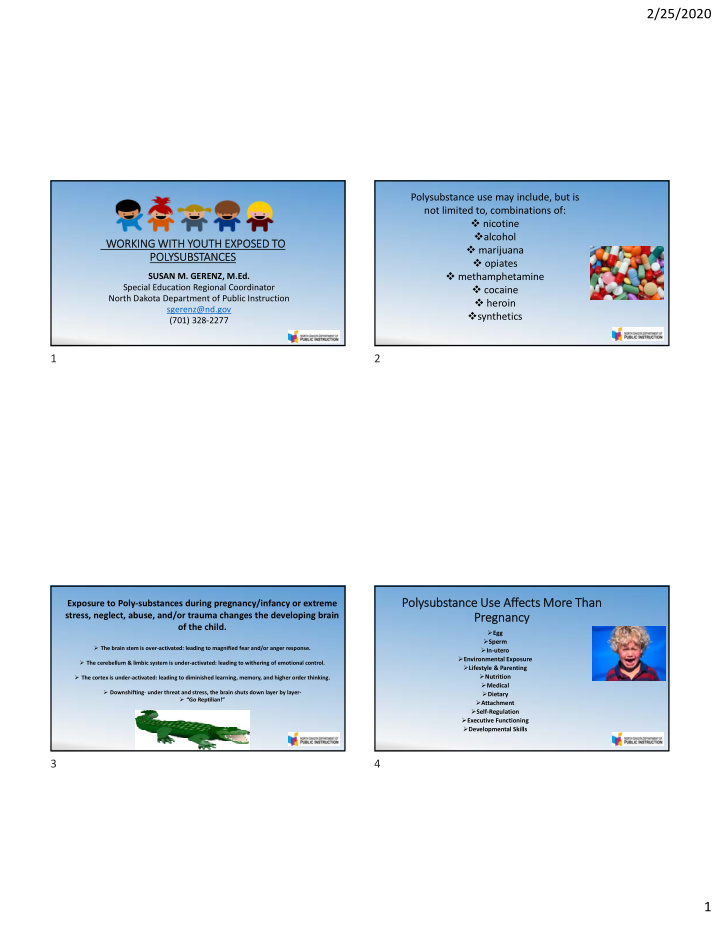



2/25/2020 Polysubstance use may include, but is not limited to, combinations of: nicotine alcohol WORKING WI WO WITH TH YO YOUTH EXPO EXPOSED TO TO marijuana POL POLYSUBS BSTANCES opiates methamphetamine SUSAN M. GERENZ, M.Ed. Special Education Regional Coordinator cocaine North Dakota Department of Public Instruction heroin sgerenz@nd.gov synthetics (701) 328 ‐ 2277 1 2 Polysub substance nce Use Use Af Affects cts Mor More Than Than Exposure to Poly ‐ substances during pregnancy/infancy or extreme stress, neglect, abuse, and/or trauma changes the developing brain Pre Pregnanc ncy of the child. Egg Sperm The brain stem is over ‐ activated: leading to magnified fear and/or anger response. In ‐ utero Environmental Exposure The cerebellum & limbic system is under ‐ activated: leading to withering of emotional control. Lifestyle & Parenting Nutrition The cortex is under ‐ activated: leading to diminished learning, memory, and higher order thinking. Medical Downshifting ‐ under threat and stress, the brain shuts down layer by layer ‐ Dietary “Go Reptilian!” Attachment Self ‐ Regulation Executive Functioning Developmental Skills 3 4 1
2/25/2020 Effects on Brain and Central Nervous System Development: Observations of Children in Psychiatric Residential Treatment who are likely polysubstance exposed Disruption in migration of cells ‐ movement along branches 1. Non ‐ categorical delays: across many life domains 2. Autism ‐ like symptoms: communication, socialization, behavior Shorter dendrites ‐ difficulty carrying information 3. Psychotic symptoms: disorganized thinking, personality changes, limited insight, social impairments Reduced myelin insulating the neurons ‐ slower information processing and less white 4. Childhood schizophrenia symptoms: auditory/visual hallucinations, matter paranoia, delusions, bizarre behavior Impaired cell survival 5. “Children with no skin!” 6. “FAS on steroids!” 5 6 Polysubstance Exposure Impacts: POLYSUBSTANCE EXPOSURE IS CHARACTERIZED BY LONG RANGE Working Memory and Information processing UNDER ‐ CONNECTIVITY Provide extra processing time Offer visual cues/multisensory learning Impacts integration of skills important for language, social skills, and sensory ‐ motor. Face ‐ emotion labeling Impacts frontal lobe executive functions: Requires direct instruction, repetition & overlearning Working memory Prerequisite for empathy skills Planning and organization Self ‐ regulation Perspective taking Focus/attention in emotional situations Empathy and compassion Use coping/calming techniques before presenting verbal information or directives 7 8 2
2/25/2020 • HOOK UPS • CROSS LATERAL MARCH Processing Coping Skills are designed to help you • RHYTHMIC CLAPPING work through thoughts and feelings you have about • JUMPING JACKS challenging situations. Some suggestions: • FULL BODY BREATHING Make a coping box • WALKING OUTSIDE Write poetry • SWINGING ON SWINGS Use a journal • RIDING BIKE Use a feelings thermometer Create a playlist to listen to • DANCING • CLIMBING STAIRS • PLAYING CATCH OR FRISBEE copingskillsforkids.com 9 10 CLOSING THOUGHTS SOCIAL EMOTIONAL LEARNING COMPETENCIES NDMTSS “This isn’t something else on the plate; this is our plate. Once you get the plate established, everything else flourishes.” http://www.ndmtss.org/wp ‐ content/uploads/2019/06/39545 ‐ 6 ‐ 1 ‐ 18 ‐ Compiled ‐ NDMTSS ‐ SEL ‐ Scales.pdf Rennie Center on Education Research & Policy 11 12 3
Recommend
More recommend